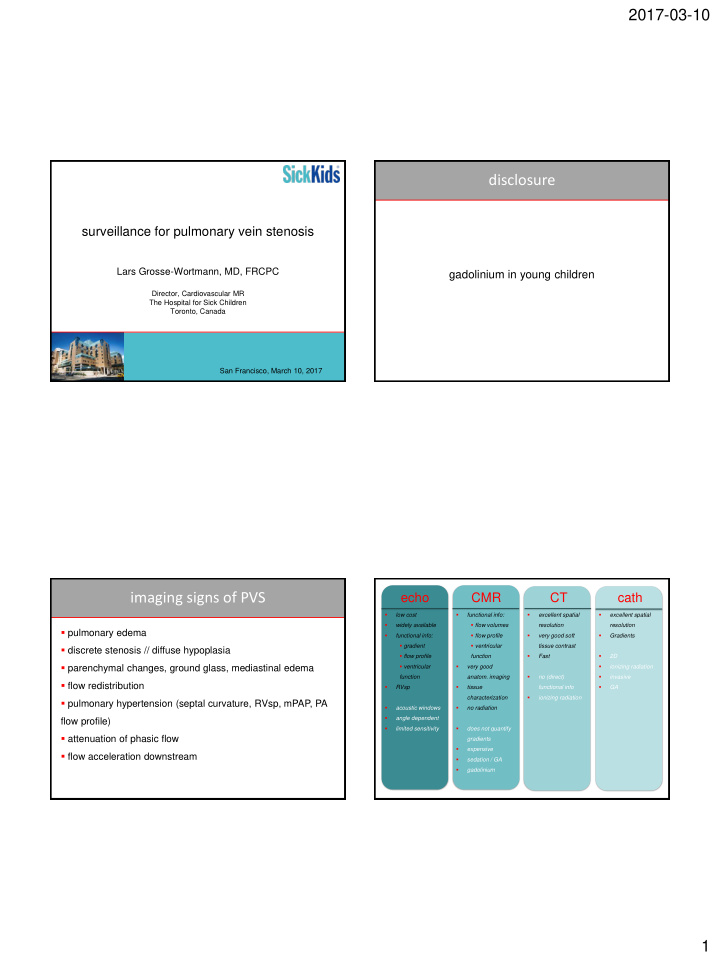



2017-03-10 disclosure surveillance for pulmonary vein stenosis Lars Grosse-Wortmann, MD, FRCPC gadolinium in young children Director, Cardiovascular MR The Hospital for Sick Children Toronto, Canada San Francisco, March 10, 2017 imaging signs of PVS echo CMR CT cath low cost functional info: excellent spatial excellent spatial flow volumes widely available resolution resolution pulmonary edema functional info: flow profile very good soft Gradients gradient ventricular tissue contrast discrete stenosis // diffuse hypoplasia flow profile function Fast 2D parenchymal changes, ground glass, mediastinal edema ventricular very good ionizing radiation function anatom. imaging no (direct) invasive flow redistribution RVsp tissue functional info GA characterization ionizing radiation pulmonary hypertension (septal curvature, RVsp, mPAP, PA acoustic windows no radiation angle dependent flow profile) limited sensitivity does not quantify attenuation of phasic flow gradients expensive flow acceleration downstream sedation / GA gadolinium 1
2017-03-10 MRA contrast-enhanced contrast-enhanced non-contrast not ECG gated ECG gated ECG gated breathhold respiratory navigated respiratory navigated JCMR 2011 Grosse-Wortmann, JACC 2007 Grosse-Wortmann, JACC 2007 2
2017-03-10 case 1: 4/12 ♂ , AVSD, large PDA case 1: 4/12 ♂ , AVSD, large PDA PVRi (WU*m 2 ) Qp/Qs FiO 2 0.3 6.3 2.7 FiO 2 0.6 6.1 3.1 FiO 2 & NO 5.5 learning points gradient may be overestimated with flow full hemodynamic assessment, including Qp/Qs and PVR, is helpful in decision making 4 months post-op 4 months post-op stents in RUPV&LUPV stents in RUPV&LUPV 1 month post-op 2 months post-op dilation of RLPV&LLPV 1 month post-op 2 months post-op dilation of RLPV&LLPV learning points PVS can progress rapidly imaging of bioabsorbable stent feasible with CT 3
2017-03-10 case 3: 3/12 ♀ , s/p AVSD repair, LPV repair case 4: 2 years 10/12 ♀ , RAI, AVSD, TGA, PA, mixed TAPVC, s/p AVSD repair, RV-PA conduit, sutureless repair RU+MPV recurrent chest infections right pleural effusion increased LLPV gradient ? RV/PA conduit exchange ? LLPV repair ? PAPVC repair learning points PA (wedge) angiography ≠ direct PV injection ? APC occlusion? distinction between discrete narrowing and diffuse ► Qp/Qs, aortopulmonary collateral flow, PA flow hypoplasia can be challenging by cross-sectional imaging distribution, RVEDV, RVEF case 4: 2 years 10/12 ♀ , RAI, AVSD, TGA, PA, mixed TAPVC, s/p AVSD case 5: 9 months ♂ , RUPV&RLPV stenosis repair, RV-PA conduit, sutureless repair RU+MPV total Qp/Qs = 1.7 no significant LLPV obstruction RVEDVi 207ml/m 2 , RVEF 33% learning points decision making can be complex +6 months CMR provides hemodynamic information that is important for management CMR can be performed without sedation / GA in young children 4
2017-03-10 case 5: 9 months ♂ , RUPV&RLPV stenosis RPA LPA learning points PVS can be associated with mediastinal, perivascular and peribronchial edema / lymphatic dilatation PVS induces aortopulmonary collaterals ipsilateral PA flow can be reduced and net flow can be retrograde case 6: 16 months ♂ , prematurity, BPD, hemoptysis case 7: 16 months ♂ , prematurity, BPD, hemoptysis learning points prematurity and bronchopulmonary dysplasia are risk ? mediastinal factors for development of PVS hemangioma the obstructed PV can be decompressed via PV-to-PV collaterals PV-to-systemic venous collaterals 5
2017-03-10 case 8: 5 year ♀ , RAI, unbalanced AVSD, DORV, PS, case 9: 5 year ♀ , RAI, unbalanced AVSD, DORV, PS, TAPVC, s/p TAPVC repair & bilateral BCPC TAPVC, s/p TAPVC repair & bilateral BCPC MRI 1 MRI 2 MRI 3 RPA flow (l/min/m 2 ) .93 1.18 3.47 LPA flow (l/min/m 2 ) .73 -.33 -3.06 LLPV flow (l/min/m 2 ) 1.01 .1 .02 Qp/Qs .63 .66 1.76 Grosse-Wortmann, Cardiol Young 2007 learning points PVS can be associated with development of massive aorto-pulmonary collaterals, especially in patients with BCPC or Fontan circulations Grosse-Wortmann, Cardiol Young 2007 surveillance CT or MRI ? default = MRI consider palliation or HLTx diagnosis CT 1 month ?stent [cath] comparison with previous CT echo, x-sectional surgery / cath functional status known or not relevant for mx GA for MRI to be avoided 3-6 months renal failure echo, x-sectional progression airway // pulmonary parenchymal // mediastinal imaging 12 months echo, x-sectional 6
2017-03-10 summary future directions clinical question choice of imaging modality ► screening by echocardiography for select patients echo does not reliably r/u PVS ► image fusion MRI angiography: ECG gated, contrast-enhanced ► non-contrast MR angiography CT angiography: preferably ECG gated MRI can be performed without sedation / GA in ► predictive value of imaging biomarkers infants and preschool children ► role of exercise echocardiography & CMR cath may be needed to determine patency Shi-Joon Yoo save the date Rachel Vanderlaan Christopher Caldarone Andreea Dragulescu Andrea Wan Hartmut Grasemann Tilman Humpl Jennifer Russell 7
Recommend
More recommend